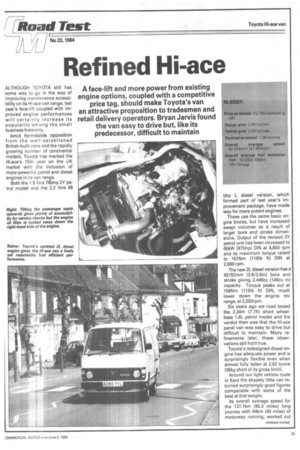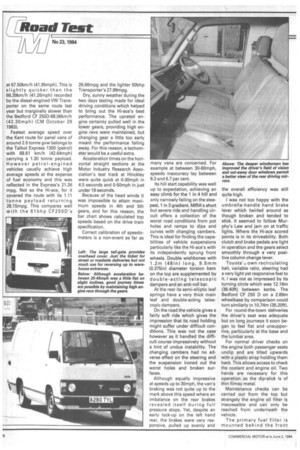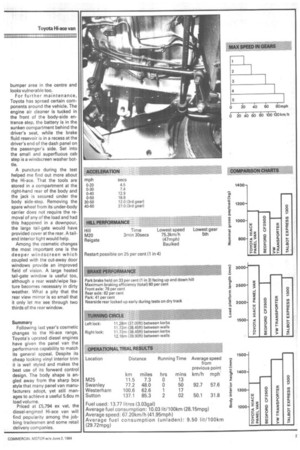Refined Hi-ace
Page 27

Page 28

Page 29

If you've noticed an error in this article please click here to report it so we can fix it.
A face-lift and more power from existing engine options, coupled with a competitive price tag, should make Toyota's van an attractive proposition to tradesmen and retail delivery operators. Bryan Jarvis found the van easy to drive but, like its predecessor, difficult to maintain
ALTHOUGH TOYOTA still has some way to go in the way of improving maintenance accessibility on its Hi-ace van range, last year's face-lift coupled with improved engine performances will certainly increase its popularity among the small business fraternity.
Amid formidable opposition from the well-established British-built vans and the rapidly growing number of continental models, Toyota has marked the Hi-ace's 15th year on the UK market with the inclusion of more-powerful petrol and diesel engines in its van range.
Both the 1.8 litre 78bhp 2Y petrol model and the 2.2 litre 66 bhp L diesel version,. which formed part of last year's improvement package, have made way for more potent engines.
These use the same basic engine blocks, but have increased swept volumes as a result of larger bore and stroke dimensions. Output of the revised 3Y petrol unit has been increased to 65kW (87bhp) DIN at 4,600 rpm and its maximum torque raised to 157Nm (116Ib ft) DIN at 2,600 rpm.
The new 2L diesel version has a 92/92mm (3.6/3.6in) bore and stroke giving 2,446cc (149cu in) capacity. Torque peaks out at 156Nm (115Ib ft) DIN, much lower down the engine rev range, at 2,200rpm.
Six years ago we road tested the 2.34m (7.7ft) short wheelbase 1.6L petrol model and the verdict then was that the Hi-ace panel van was easy to drive but difficult to maintain. Many refinements later, these observations still hold true.
Toyota's redesigned diesel engine has adequate power and is surprisingly flexible even when almost fully laden at 2.62 tonne (36kg short of its gross limit).
Around our light vehicle route in Kent the shapely little van returned surprisingly good figures comparable with some of the best at that weight.
Its overall average speed for the 137.1km (85.3 miles) long journey with 64km (40 miles) of motorway running, worked out at 67.50km/h (41.95mph). This is slightly quicker than the 66.39km/h (41.26mph) recorded by the diesel-engined VW Transporter on the same route last year but marginally slower than the Bedford CF 250D-68.06km/h (42.30mph) (CM October 29 1983).
Fastest average speed over the Kent route for panel vans of around 2.5 tonne gvw belongs to the Talbot Express 1300 (petrol) with 68.61 km/h (42.64mph) carrying a 1.30 tonne payload. However petrol-engined vehicles usually achieve high average speeds at the expense of fuel economy and this was reflected in the Express's 21.26 mpg. Not so the Hi-ace, for it covered the route with its 1.11 tonne payload returning 28.15mpg. This compares well with the 6 1 bhp CF2 5 OD's 26.66mpg and the lighter 50bhp Transporter's 27.99mpg.
Dry, sunny weather during the two days testing made for ideal driving conditions which helped to bring out the Hi-ace's best performance. The uprated engine certainly pulled well in the lower gears, providing high engine revs were maintained, but changing gear a little too early meant the performance falling away. For this reason, a tachometer would be a useful extra.
Acceleration times on the horizontal straight sections at the Motor Industry Research Association's test track at Hinckley were quite quick at 0-30mph in 4.5 seconds and 0-50mph in just under 19 seconds.
Because of the head winds it was impossible to attain maximum speeds in 4th and 5th gears, and for this reason, the bar chart shows calculated top speeds based on the drive train specification.
Correct calibration of speedometers is a non-event as far as many vans are concerned. For example at between 30-60mph, speedo inaccuracy lay between 8.3 and 6.7 per cent.
Its hill start capability was well up to expectation, achieving an easy climb for the 1 in 4 hill and only narrowly failing on the steepest, 1 in 3 gradient. MIRA's short but severe ride and handling circuit offers a collection of the worst road conditions from pot holes and ramps to dips and curves with changing cambers. This is ideal for finding the capabilities of vehicle suspensions particularly like the Hi-ace's with its independently sprung front wheels. Double wishbones with 1.2m (4 8in) long, 9.5mm (0.375in) diameter torsion bars on the top are supplemented by double-acting telescopic dampers and an anti-roll bar.
At the rear its semi-elliptic leaf springs have a very thick main leaf and double-acting telescopic dampers.
On the road the vehicle gives a fairly soft ride which gives the impression that its road holding might suffer under difficult conditions. This was not the case however as it handled the difficult course impressively without a hint of undue instability. The changing cambers had no adverse effect on the steering and the suspension ironed out the worst holes and broken surfaces.
Although equally impressive at speeds up to 30mph, the van's braking was not quite up to the mark above this speed where an imbalance on the rear brakes revealed itself during full pressure stops. Yet, despite an early lock-up on the left hand rear, the brakes were very responsive, pulled up evenly and the overall efficiency was still quite high.
I was not too happy with the umbrella-handle hand brake lever which twirled around as though broken and tended to stick. It seemed to follow Murphy's Law and jam on at traffic lights. Where the Hi-ace scored points is in its driveability. Both clutch and brake pedals are light in operation and the gears select smoothly through a very positive column change lever.
Toyota', own recirculating ball, variable ratio, steering had a very light yet responsive feel to it. I was not as impressed by its turning circle which was 12.16m (38.40ft) between kerbs. The Bedford CF 250 D on a 2.69m wheelbase by comparison could turn similarly in 10.74m (35.20ft).
For round-the-town deliveries the driver's seat was adequate but on long journeys it soon began to feel flat and unsupportive, particularly at the base and the lumbar area.
For normal driver checks on the engine both passenger seats unclip and are tilted upwards with a plastic strap holding them back. This allows access to check the coolant and engine oil. Two hands are necessary for this operation as the dip-stick is of thin flimsy metal.
Maintenance checks can be carried out from the top but strangely the engine oil filter is inaccessible and can only be reached from underneath the vehicle.
The primary fuel filter is mounted behind the front bumper area in the centre and looks vulnerable too.
For further maintenance, Toyota has spread certain components around the vehicle. The engine air cleaner is tucked in the front of the body-side entrance step, the battery is in the sunken compartment behind the driver's seat, while the brake fluid resevoir is in a recess at the driver's end of the dash panel on the passenger's side. Set into the small and superfluous cab step is a windscreen washer bottle.
A puncture during the test helped me find out more about the Hi-ace. That the tools are stored in a compartment at the right-hand rear of the body and the jack is secured under the body side-step. Removing the spare wheel from its under-body carrier does not require the removal of any of the load and had this happened in a downpour, the large tail-gate would have provided cover at the rear. A tailend interior light would help.
Among the cosmetic changes the most important one is the deeper windscreen which coupled with the cut-away door windows provide an improved field of vision. A large heated tail-gate window is useful too, although a rear wash/wipe feature becomes necessary in dirty weather. What a pity that the rear view mirror is so small that it only let me see through two thirds of the rear window.
Summary Following last year's cosmetic changes to the Hi-ace range, Toyota's uprated diesel engines have given the panel van the performance capability to match its general appeal. Despite its cheap looking vinyl interior trim it is well styled and makes the best use of its forward control design. The body shape is angled away from the sharp box style that many panel van manufacturers adopt, yet still manages to achieve a useful 5.6cu m load volume.
Priced at £5,794 ex vat, the diesel-engined Hi-ace van will find popularity among the jobbing tradesmen and some retail delivery companies.
























































































